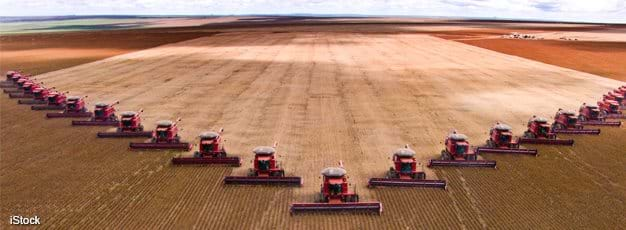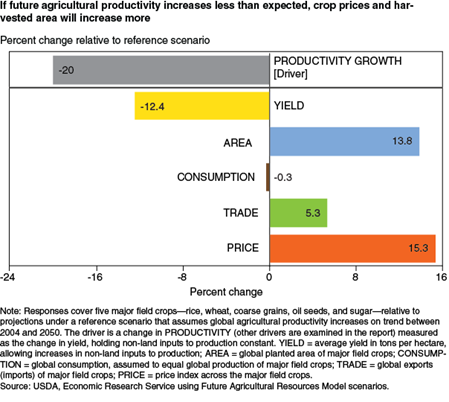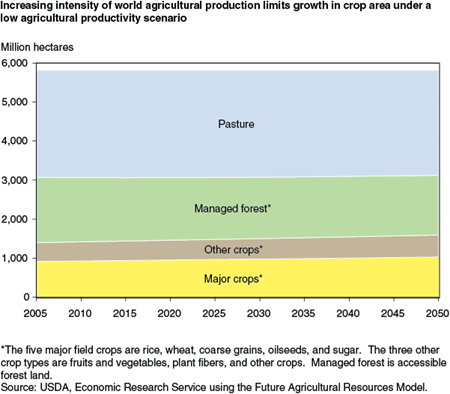With Adequate Productivity Growth, Global Agriculture Is Resilient to Future Population and Economic Growth

Highlights:
-
As global population and incomes increase over the next four decades, demand for agricultural commodities is also expected to increase.
-
Growth in agricultural productivity will determine how agricultural input, output, and land markets will adjust to increased demand.
-
A continuation of recent productivity growth trends should allow the agricultural sector to respond to increased demand with little additional use of land and other agricultural inputs, but a slowdown in productivity growth could result in high agricultural commodity prices and additional environmental stress.
Rapid improvements in agricultural productivity in recent decades have freed resources such as land and labor for nonagricultural uses, dampened the environmental impact of farming, and made food more affordable to a growing world population. However, prospects for future growth in agricultural productivity are uncertain, particularly in light of climate change. If agricultural productivity growth slows in future years, how will global agricultural output, consumption, land use, and prices adjust? To address this question, ERS researchers recently used the agency’s global agricultural and energy economic model—the Future Agricultural Resources Model (FARM)—to simulate agricultural markets in 2050 under a range of different scenarios.
In trying to project future global agricultural production and resource use decisions given varying technological changes, we developed two scenarios: (1) a global agricultural economy with moderate population, income, and agricultural productivity growth over the next four decades and (2) a low-productivity scenario that reflects a less optimistic outlook for future agricultural productivity growth. By comparing these two scenarios, we can judge how farmers and consumers could be expected to react should future agricultural productivity growth slow for any reason.
Population, Income, and Productivity Growth Drive Agricultural Trends
While demand for and supply of agricultural output are influenced by a wide array of factors, the framework adopted for this study assumes that population, income, and agricultural productivity growth are the major drivers of long-term trends in agricultural output, land use, and prices. Other drivers are assumed to remain constant or enter the model by influencing one or more of these three principal factors. The two scenarios considered here both assume that world population and income will increase at moderate rates through 2050.
Population projections are from the United Nations' medium-fertility scenario and vary by world region. The world’s population is projected to grow by approximately one-third, from 6.9 billion people in 2010 to 9.3 billion in 2050, but population growth rates vary considerably among individual countries and the model’s 13 world regions. For example, population growth in sub-Saharan Africa is expected to accelerate in the early 2020s at about the same time that China’s population is projected to level off and start declining. As a result, by 2040, China’s population is expected to be lower than the populations of India and sub-Saharan Africa. Consumption of major field crops is projected to grow at about the same rate as the population increases, other things being equal.
Global per capita income is projected to double in real terms (that is, after adjustment for inflation), increasing from roughly $7,000 per person in 2010 to roughly $14,000 by 2050 in constant U.S. dollars. Projected per capita income growth is positive in nearly all world regions, but the rate of growth varies by region. Income is projected to grow more rapidly in developing regions such as China, India, and Sub-Saharan Africa. Consumption of major field crops is projected to grow at about one-third the rate of per capita income growth, other things being equal. This primarily represents an income-induced shift in diets toward processed foods and meat, which themselves consume more field crops. For example, each calorie of chicken or pork requires at least two calories of feed, and even more feed is needed for each calorie of beef produced. As incomes in developing countries increase, food consumption shifts to diets richer in animal protein, which increases the demand for feed crops.
Finally, FARM allows for a different rate of productivity change in each production sector. Agricultural productivity growth is considered to be land-augmenting; that is, as productivity increases, less land is needed per unit of product, while requirements for other inputs are not affected. Productivity is projected to increase over time for each of eight crop types and in all world regions, although projected growth rates are not as high as recent historical growth rates in crop yield. Average annual percentage growth rates range from roughly 1 to 2 percent across crop groups between 2005 and 2030. The reference scenario further assumes that productivity growth slows across all crop groups between 2030 and 2050.
Agricultural Markets in 2050 Under the Reference Scenario
Combining the effects of changes in population, income, and agricultural productivity in the reference scenario, FARM projects a 75-percent increase in total production and consumption of major field crops between 2005 and 2050. This increase is larger than the 43-percent increase in global population projected for the same period, reflecting increasing per capita growth in income and the associated increase in consumption of animal products in developing countries.
In this scenario, FARM projects that the increased demand for agricultural products associated with greater incomes and a larger population can be met without significant increases in cropland area and with only modest increases in agricultural product prices. Global average yield increases in all eight crop categories over time, mostly due to relatively optimistic crop productivity growth assumptions. Projected crop price increases are modest under the reference scenario (9 percent, on average, across major field crops), but encourage farmers to grow their crops more intensively and thus also help bolster average yields. Farmers also adjust to crop price signals by expanding total cropland, but only by 5 percent, concentrated entirely in fruit, vegetable, and other minor crop acreage. For each agricultural commodity, demand equals supply at the global level, with international trade allowing for differences in demand and supply at the national level.
Analyzing the Low-Productivity Scenario
Using the reference scenario as a starting point, a low-productivity scenario was constructed to assess the economic response of farmers and consumers to a lower rate of growth in agricultural productivity. While there is general agreement on the direction and general magnitude of long-term global population and per capita income change, there is considerable uncertainty about future growth in agricultural productivity in the face of global climate change, uncertain levels of public and private investment in agricultural research and development (R&D), and other typically shorter term factors that could affect productivity trends, such as armed conflicts or extreme weather events.
In this low-productivity scenario, the reference scenario’s population and per capita income growth assumptions are not changed, but agricultural productivity rises at a slower rate, ending up 20 percent below the reference scenario in 2050. Agricultural productivity still increases through 2050 in this scenario, but not as fast as in the reference scenario.
While to some extent the assumed 20-percent decline in land-augmenting agricultural productivity may appear arbitrary, it is not outside the realm of possibility. This decline is close to the average projected productivity decline associated with high greenhouse gas emissions and climate change in a recently published study of several global agricultural economic models.
In this scenario, the global economy absorbs a 20-percent reduction in agricultural productivity through compensating increases in crop prices, which provide incentives to increase inputs of land, fertilizer, and capital as well as reducing the quantity of agricultural output demanded. Increasing international trade also plays a role in adjustments to lower projected productivity . In this analysis, outcomes are measured relative to expectations under the reference scenario in 2050, so agricultural productivity appears as a negative 20-percent productivity shock relative to the reference scenario.
Note that predicted productivity change is not the same as the change in realized yield in this exercise. The decline in productivity relative to the reference scenario means that 20 percent more land is required to grow the same quantity of crops if the amount of other inputs per ton of crop produced remains the same. Projected changes in yield also reflect the adjustment of non-land inputs to minimize the cost of producing each ton of crop in this scenario. With an increase in non-land inputs to production, the decline in yield is less than the original decline in land-augmenting productivity. Non-land inputs include capital, labor, fertilizer, and water.
While crop prices are higher as a result of the lower level of global agricultural productivity, the productivity shock is largely absorbed through increasing harvested area as well as the increased use of non-land resources on each unit of land. At a global level, the projected increase in area of major field crops harvested (nearly 14 percent) almost entirely offsets the projected decrease in yield (over 12 percent). Global production and consumption are slightly lower than in the reference scenario as consumers adjust spending patterns in response to higher crop prices. Further, the volume of international trade in crops expands by 5 percent as production shifts among world regions.
Relative to the reference scenario, the low productivity growth scenario projects nearly identical global agricultural production of five major field crops, but to hold global production and consumption of these crops nearly constant with lower agricultural productivity growth, both producers and consumers have to make adjustments. Real (inflation-adjusted) average global crop prices are 15 percent higher in 2050 relative to the reference scenario, which itself had projected some price rises. While rising per capita incomes reduce the effect of higher crop prices on global standards of living, these higher prices could require adjustments in consumer spending patterns for the world’s poorest populations.
Slower productivity growth also affects the use of land and other resources. While total area for major field crops is fairly stable in the reference scenario (declining by about 1 percent as harvested area of other crops expands slightly), under the low-productivity scenario, major field crop area is projected to expand by 12 percent relative to 2005 and 14 percent relative to the reference scenario in 2050. Land use results are similar if all eight crop types are included. Total crop area increases from 1.40 billion hectares in 2005 to 1.59 billion hectares in 2050 in the low-productivity scenario, an increase of 14 percent relative to 2005. Further increases in cropland area are limited due to competition for land among crops, pasture, and forest, making conversion to crop production increasingly expensive.
In addition, land planted to crops will need to be farmed more intensively to attain the yields necessary to hold production fairly constant without increasing land conversion and prices even more than projected. Farming more land more intensively will divert resources from other uses and will have environmental implications that could exacerbate water shortages, greenhouse gas emissions, and other environmental problems. While these impacts are not reflected in projections of global gross domestic product and per capita income, they have implications for the quality of life in the future. These implications are not explored here, but are left to future research.
This study started with a reference scenario based on population and income projections through 2050, with sufficient gains in agricultural productivity over time to maintain stable cropland area with only modest increases in crop prices. However, productivity growth could be lower, depending on the level of future agricultural research or climate change.
The reference scenario used the medium-fertility population growth projections from the United Nations, which envision significant population growth, along with agricultural productivity growth projections that are close to—but not quite as high as—recent historical trends. Either a slower rate of agricultural productivity growth, as assumed in our alternative scenario, or a faster rate of population growth would be expected to lead to higher crop prices to provide incentives for producers to increase cropland area and non-land agricultural inputs. Under reasonable assumptions, the agricultural sector can adapt to such shocks, but the resulting increases in prices and in resource use have the potential to be costly for both consumers and the environment.
<a name='sidebar'>The Future Agricultural Resource Model (FARM)</a>
FARM is a global economic model that provides simulations over a 50-year timespan, starting in 2004. In this application of the model, land use is allowed to shift among crops, pasture, and forests in response to population and income growth, and changes in agricultural productivity. For ease of exposition, model projections are presented for the 2005 to 2050 period.
The main drivers of agricultural demand and supply that are of interest in this article, and the resulting adjustments in agricultural markets simulated by FARM, are listed below.
| Population (demand-side driver) | The United Nations projects world population to be approximately 9.3 billion people by 2050 in its medium-fertility scenario |
|---|---|
| Income (demand-side driver) | Per capita real Income is projected to double by 2050. |
| Agricultural productivity (supply-side driver) | Increasing land productivity allows crop yield to grow, even as other inputs to agricultural production are held constant. |
| Crop prices (world market price) | Prices are calculated within the economic model so that world agricultural demand matches supply. |
| Crop production (by world region) | Production increases along with world prices. |
| Crop consumption (by world region) | Consumption increases as per capita income increases. |
| International trade in agricultural products (among world regions) | Trade is calculated as the difference in production and consumption of agricultural products in each world region. |
| Crop yield (by world region) | Yield depends on assumptions about agricultural productivity and the ability to substitute other inputs (such as fertilizer) for land. |
| Land used for each agricultural product in each world region | Land is allocated to alternative uses in each land class until rates of return are equalized. |
Global Drivers of Agricultural Demand and Supply, by Ron Sands, Carol Jones, and Elizabeth Marshall, USDA, Economic Research Service, September 2014
“Climate Change Effects on Agriculture: Economic Responses to Biophysical Shocks”, by G.C. Nelson, H. Valin, R.D. Sands, P. Havlik, H. Ahammad, D. Deryng, J. Elliott, S. Fujimori, T. Hasegawa, E. Heyhoe, P. Kyle, M. von Lampe, H. Lotze-Campen, D. Mason d’Croz, H. van Meijl, D. van der Mensbrugghe, C. Müller, A. Popp, R. Robertson, S. Robinson, E. Schmid, C. Schmitz, A. Tabeau, and D. Willenbockel, November 2014, in Proceedings of the National Academy of Sciences (special feature), Vol. 111, No. 9: 3274-3279
“A New Scenario Framework for Climate Change Research: The Concept of Shared Socio-Economic Pathways,” by B.C. O’Neill, E. Kriegler, K. Riahi, K. Ebi, S. Hallegatte, T.R. Carter, R. Mathur, and D.P. van Vuuren, in Climatic Change, Vol. 122, No. 3: 387-400, February 2014





